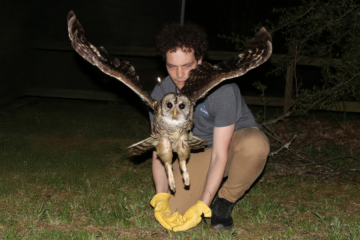A high-pitched screech echoed through the night as a research team from William & Mary ventured into the woods of Newport News Park to study barred owls. Led by Matthias Leu, chair of the biology department, the group aims to capture a female barred owl for the second time, following an initial capture two months prior. Equipped with a GPS backpack that tracks the owl’s location, activity, and temperature, the team hopes to collect data that could shed light on how wildlife is adapting to urban environments.
Barred owls are among the many species facing threats from what scientists refer to as the “Sixth Mass Extinction,” a rapid decline in biodiversity driven by human activities such as climate change, pollution, and habitat destruction. According to a 2022 study, urban land expansion could cover up to 1.53 million square kilometers by 2050, potentially impacting over 800 species. The research conducted by Leu and his students seeks to understand how urban development reshapes the habitats of barred owls, which were once thought to inhabit only rural woodlands. Increasing evidence suggests they are now thriving in more developed landscapes.
Justin Biggerstaff, the biology master’s student leading the project, emphasized the significance of understanding the owls’ habitat use. “If we can understand how they use this habitat — where they roost, where they hunt, and what areas they avoid — we can provide valuable information about the types of landscapes that support coexistence between wildlife and people,” he remarked. This study is unique in its geographical focus, aiming to compare findings with research from California, North Carolina, and Louisiana to create a broader understanding of barred owl behavior.
Biggerstaff is particularly focused on the impact of roads on owl activity. “Owls are very auditory-based animals,” he explained. Their physical adaptations, including large ear openings surrounded by soft feathers, enable them to detect the faint sounds of prey. The team hypothesizes that noise from road traffic could hinder the owls’ ability to locate prey, leading them to avoid high-noise environments. Biggerstaff noted that younger owls, which are less experienced, face additional risks when crossing roads, as they may not recognize the dangers.
To investigate these questions, the team has spent countless hours in the field capturing owls. They have become accustomed to the nocturnal lifestyle, often setting up traps in local parks and private properties. The researchers carry bulky equipment, including aluminum poles and specialized nets designed to ensnare the owls. “We need a clear corridor of forest,” Biggerstaff stated, explaining how the trees guide the owls into their nets.
Once a promising location is identified, the team constructs a net that stretches approximately 36 feet long and 20 feet high. The trap consists of three smaller nets layered together, creating an almost invisible barrier at dusk. To attract the barred owls, the team plays recorded owl calls from speakers strategically positioned around the net, taking advantage of the birds’ territorial instincts.
Despite their efforts, the research team faced challenges during their outings. After spending nearly four hours in one session without capturing an owl, they decided to pack up. As they prepared to leave, the female owl and her male counterpart continued to hoot nearby, seemingly mocking their attempts. “Now they’re just rubbing it in,” Leu remarked, laughing as they dismantled the nets.
The team plans to continue their fieldwork until the battery life of their transmitters runs out. Following each capture, the researchers analyze the data collected to determine the energy expenditure of the owls and the quality of their habitats. Biggerstaff expressed his hopes for the project, stating, “Analyzing activity patterns can help us understand how much energy the owls are using. Comparing energy use with habitat use gives us an idea of habitat quality.”
With their ongoing research, Leu, Biggerstaff, and their team aim to contribute valuable insights into how urbanization affects wildlife. Their work not only focuses on the barred owls of Virginia but is also part of a larger effort to understand the dynamics of wildlife in an increasingly human-dominated world. As they prepare for future outings, they remain committed to uncovering the complexities of these fascinating birds and their adaptability to changing environments.
